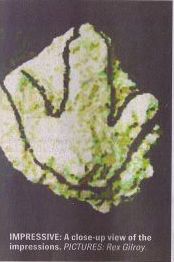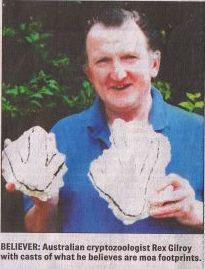
January 9, 2008

As a followup to the recent story about Rex Gilroy’s proposed expedition to look for living Moas in the Urewera forest, Tony Lucas shares the latest.

Hawke’s Bay cryptozoology researcher Tony Lucas is keeping an open mind on the possibility of moa still being alive in the Ureweras but thinks the evidence could point to emus.
Mr Lucas, unable to join the hunt for New Zealand’s hidden species because of ill health, and who is confining his role mainly to researching other reports, says modern claims of moa sightings in New Zealand have mainly been in the South Island.
The greater human population of the North Island has made it less likely that moa could exist without being found.
But he says there have been emus in the Ureweras, where Australian cryptozoologists Rex and Heather Gilroy plan to start a new search for moa at the end of next month.
They have plaster casts of possible moa prints seen mainly in mud in the area six years ago, and on another visit in November found harder tracks and evidence of what they believe may have been a nesting area.
Mr Lucas, who operates the website nzcryptozoologist0.tripod.com – which has had more than 1500 hits in it first year – hopes reports of sightings of moa and other species presumed extinct will encourage others who have kept sightings secret for fear of ridicule to come forward with their evidence.
He is concerned that sightings made by New Zealanders in New Zealand don’t seem to be taken as seriously as those reported by visitors such as Rex and Heather Gilroy, but there have been many claims of sightings of unusual animals over the years.
His own interest began when, as a youngster, he heard about his uncles’ sighting of an unusual beast in the Ruahines. “They were terrified and wouldn’t speak about it,” he said.
It wasn’t something they would talk about, but it resembled the moehau, a half-man half- beast type of being reported to have been seen in earlier times in the Coromandel.
Such fears were heightened by reports of the deaths of two people in that area in the 1880s.
Mr Lucas says there are several cryptozoologists active in New Zealand, and his own website includes research of many sightings.
They range from the moehau, big cats such as the panther-like creature reported on the Canterbury Plains, and giant gecko and lizards, to the moa. by Doug Laing, “First it was moa, now it’s emus? ,” 8 January 2008, Hawke’s Bay Today
About Loren Coleman
Loren Coleman is one of the world’s leading cryptozoologists, some say “the” leading living cryptozoologist. Certainly, he is acknowledged as the current living American researcher and writer who has most popularized cryptozoology in the late 20th and early 21st centuries.
Starting his fieldwork and investigations in 1960, after traveling and trekking extensively in pursuit of cryptozoological mysteries, Coleman began writing to share his experiences in 1969. An honorary member of Ivan T. Sanderson’s Society for the Investigation of the Unexplained in the 1970s, Coleman has been bestowed with similar honorary memberships of the North Idaho College Cryptozoology Club in 1983, and in subsequent years, that of the British Columbia Scientific Cryptozoology Club, CryptoSafari International, and other international organizations. He was also a Life Member and Benefactor of the International Society of Cryptozoology (now-defunct).
Loren Coleman’s daily blog, as a member of the Cryptomundo Team, served as an ongoing avenue of communication for the ever-growing body of cryptozoo news from 2005 through 2013. He returned as an infrequent contributor beginning Halloween week of 2015.
Coleman is the founder in 2003, and current director of the International Cryptozoology Museum in Portland, Maine.
Filed under Breaking News, Cryptotourism, CryptoZoo News, Cryptozoologists, Cryptozoology, Extinct, Footprint Evidence, Fossil Finds, Out of Place, Thylacine